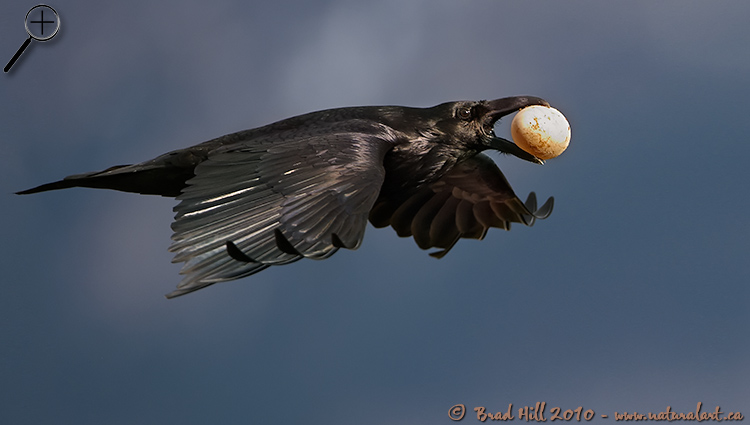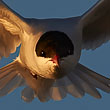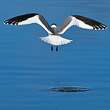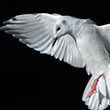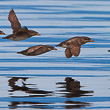Availability: Undetermined - Enquiries?
In the Field
Ravenous - And One Fewer Goose Ritchey's Point, Wilmer, BC, Canada. April 9, 2009.
I captured this image at the very end of an unsuccessful bout of eagle photography. I had spent the afternoon perched above a cliff overlooking the Columbia Wetlands in SE British Columbia in a spot where I knew Bald Eagles often soared by. But on this day they (and all the other birds) declined to cooperate. Just after I had packed up my gear and shouldered my camera and tripod in preparation to the hike back to my vehicle I took one final look down along the cliff face - and noticed a VERY dark eagle with a totally white face (and, strangely, no yellow bill) flying directly at me. I quickly planted my tripod and attempted to focus on the approaching eagle. At the last minute the "eagle" turned and gave me this broad-side view. And, as you can see, it turned out that it wasn't an eagle at all, but rather a Common Raven with one VERY full beak of Canada Goose egg!
Capturing this image and processing the image was a bit of a challenge - the brilliantly white egg was many, many times brighter than the plumage of the raven and tested the limits of the dynamic range of my camera's sensor. Fortunately, my exposure retained enough shadow and highlight image data to allow me to produce this image (using the "exposure composite" technique I've described many times on this website).
I consider this an interesting documentary/novelty image and not even remotely a work of art (I wouldn't even consider offering this image up as a Limited Edition Print). I've noticed that images of natural behavioural interactions that aren't sanitized, like this shot of predation/kleptoparasitism*, often illicit strong, visceral reactions from viewers. Couple that bias with the negative (and almost "evil") impression that many folks have of ravens...and I'm sure there will be a lot of folks thinking this raven is doing something "wrong" (or "cruel" or even "evil"). On the other hand, I do know many folks who list ravens as among their favourite birds and others who consider the Canada Goose a pest - and they'll be cheering for the raven. Overall, though, I'm sure almost no one will be indifferent to this image! I'll update this commentary once I have a few written reactions to this image...
*Technically the act captured here doesn't qualify as true kleptoparasitism, which is defined as "...a form of feeding where one animal takes prey from another animal that has caught, killed, or otherwise prepared the prey, including stored food. Kleptoparasitsm is also the 'stealing' of nest material or other inanimate objects from one animal by another." Wikipedia.
Behind the Camera
Ravenous - And One Fewer Goose Ritchey's Point, Wilmer, BC, Canada. April 9, 2009.
Digital Capture; Compressed RAW (NEF) 14-bit format; ISO 560.
Nikon D3 with AF-S Nikkor 600mm f/4G IF-ED II VR lens supported on Gitzo 1348 carbon fibre tripod with Wimberley head. VR turned to "On" and in "Normal" mode. Autofocus set to M/a mode.
1/1250s @ f5; -0.3 stop compensation from matrix-metered exposure setting.
At the Computer
Ravenous - And One Fewer Goose Ritchey's Point, Wilmer, BC, Canada. April 9, 2009.
RAW Conversion to 16-bit TIFF, including first-pass/capture sharpening and shadow/highlight adjustments using Phase One's Capture One Pro 4.7. Three RAW conversions at different exposure settings: -1.5 stop compensation for highlight detail (the egg); -0.75 stops for background; -0.25 stops for the raven.
Further digital corrections on 16-bit TIFF file using Adobe's Photoshop CS4. Adjustments included compositing and masking of 3 exposure versions and selective sharpening for web output.
Conservation
Ravenous - And One Fewer Goose Ritchey's Point, Wilmer, BC, Canada. April 9, 2009.
Ten percent of the revenue generated by this image will be donated to Wildsight.
Species Status in Canada*: This species is not designated as at risk.
The majestic Common Raven (Corvus corax) has an extremely broad geographic and ecological distribution - its natural distribution is one of the widest in the world. One factor contributing to this wide distribution is the huge range of foods (and feeding behaviour) of the raven - it's a scavenger, predator AND kleptoparasite. Its diet includes carrion, large numbers of arthropods, small rodents, bird nestlings, seeds, grains and more.
This Common Raven was photographed in the Columbia Valley of the East Kootenays. While Ravens are not considered at threat, many ecosystems within the Columbia Valley face development pressure. Wildsight is an effective conservation organization that protects biodiversity and promotes sustainable communities in Canada's Columbia and Rocky Mountains. Support for Wildsight, through donation or becoming a member, will help ensure that they remain effective in their efforts to conserve threatened or endangered species and ecosystems.
*as determined by COSEWIC: The Committee on the Status of Endangered Wildlife in Canada













